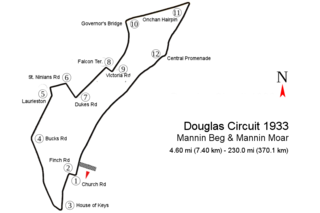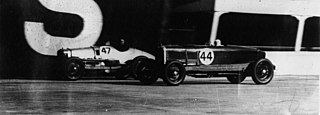
The Porsche 935 was a race car developed and manufactured by German automaker Porsche. Introduced in 1976 as the factory racing version of the 911 (930) Turbo and prepared for FIA-Group 5 rules, it was an evolution of the Carrera RSR 2.1 turbo prototype, the second place overall finisher in the 1974 24 Hours of Le Mans.
DAMS is an auto racing team from France, involved in many areas of motorsport. DAMS was founded in 1988 by Jean-Paul Driot and former Formula One driver René Arnoux. It is headquartered near Le Mans, only 2 km from the Bugatti Circuit.

Arena International Motorsport was a British motor racing team founded by Mike Earle. Earle originally ran the Onyx Formula One team from the same base in Littlehampton, before selling the team. At the end of 2012 the team's new owners, Capsicum Racing Limited, placed the company into CVA.

The Porsche 962 is a sports-prototype racing car built by Porsche as a replacement for the 956 and designed mainly to comply with IMSA's GTP regulations, although it would later compete in the European Group C formula as the 956 had. The 962 was introduced at the end of 1984, from which it quickly became successful through private owners while having a remarkably long-lived career, with some examples still proving competitive into the mid-1990s. The vehicle was later replaced by the Porsche WSC-95.

The 1989 World Sportscar Championship season was the 37th season of FIA World Sportscar Championship motor racing. It featured the 1989 FIA World Sports Prototype Championship, which was open to Group C1 Sports Prototypes, Group C2 Sports Prototypes and IMSA GTP cars. The championship was contested over an eight round series which ran from 9 April to 29 October 1989.
The 1983 World Sports Championship season was the 31st season of FIA "World Sportscar Championship" motor racing. It featured the 1983 FIA World Endurance Championship which was contested by Group C Sports Cars, Group C Junior Sports Cars and Group B GT Cars in a seven race series which ran from 10 April to 10 December 1983. The Drivers Championship was won by Jacky Ickx, the Manufacturers Championship by Porsche, the Group C Junior Cup by Alba Giannini and the Grand Touring Cup by Porsche.

Charouz Racing System is a racing team from Czech Republic, created in 1985 by Antonín Charouz.

The Rome Grand Prix, also known as the Premio Reale di Roma (1925–1932) and Gran Premio di Roma (1947–1991), was an automobile race held in Rome, Italy from 1925 until 1991.
The 1953 Carrera Panamericana was the fourth running of the Carrera Panamericana Mexican sports car racing event, and the first edition as a part of the World Sportscar Championship. The race took place from 19–23 November, and was run from Tuxtla Gutiérrez, Chiapas, to Ciudad Juárez, Chihuahua, over 8 stages and 3,077 kilometres (1,912 mi). 182 cars started the race, and 60 finished all 8 stages.
The British Sports Car Championship, was a British domestic motor racing championship which was originally created for sports cars complying with Appendix C of the International Sporting Code. For 1966 the championship was for Group 7 Sports Racing Cars and for 1967 it was restricted to Group 4 Sports Cars. By 1970, the 2-litre sports category had become very popular across Europe, therefore the organisers decided to change the championship regulations, admitting only these cars. The championship was abandoned during the 1972 season, after one race, because of a lack of entries. An attempt to re-launch the championship lead to a one-off single season being run in 1976.
The 1966 British Sports Car Championship was the third season of the British Sports Car Championship. The season was dominated by Brabham's Formula One driver, Denny Hulme, by winning the first five races of the season, abroad Sidney Taylor's Lola T70 Mk2. This model of car was also victorious in the remaining two races, in the hands of the 1964 World Champion, John Surtees.
The 1967 British Sports Car Championship was the fourth season of the British Sports Car Championship.
The 1968 RAC British Sports Car Championship was the fifth season of the British Sports Car Championship.
The 1969 British Sports Car Championship was the sixth season of the British Sports Car Championship. With exception of the Brands Hatch 6 Hours, all races were won by a Lola T70 Mk.3/Mk.3B.
The 1966 RAC Tourist Trophy saw the world’s oldest motor race, organised by the Royal Automobile Club, return to Oulton Park on 29 April, for the 31st running of the RAC International Tourist Trophy Race sponsored by Daily Express. The TT, was the second round of the British Sports Car Championship.
Although the 1967 TT was part of the European Touring Car Championship, the 1968 and 33rd running of the RAC International Tourist Trophy Race, saw a return to Group 7 sportscars. The world’s oldest motor race was the fourth round of the British Sports Car Championship. This was the held at the Oulton Park circuit, in Cheshire, England, on the 3 June.

The Douglas Circuit was a motor racing street circuit in Douglas, the capital and largest town of the Isle of Man and was re-configured each year until 1937. The first Grand Prix, titled "Mannin Beg & Mannin Moar" was held in 1933 on a 4.60 mi (7.40 km) street circuit which repeated as II and III Mannin Moar on different circuit layouts until 1935. In 1936 the circuit changed again for the IV RAC International Light Car Race and a last time for the (1937) V RAC International Light Car Race.

The British Empire Trophy was a motor race in the United Kingdom. Since its inception in 1932, the Empire Trophy was hosted at five different circuits and awarded for ten separate racing categories. The race was run a total of 42 times, spanning over eight decades, making it one of the longest running and most prestigious racing events.

The 12 Hours of Reims were a sports car endurance racing series held from 1953 to 1967 at the Reims (Gueux) circuit in the Marne district of the Champagne region in north-eastern France. The 1926 Coupe d’Or was the first 12-hour endurance race held at Reims and is considered to be the direct ancestor of the modern endurance series.

The 1953 RAC Tourist Trophy was a motor race for sports cars, held on 5 September 1953 at the Dundrod Circuit in County Antrim, Northern Ireland. It was the sixth round of the 1953 World Sportscar Championship, held just six days after the previous round, the 1000km of Nürburgring. The race was the 20th running of the RAC Tourist Trophy.









